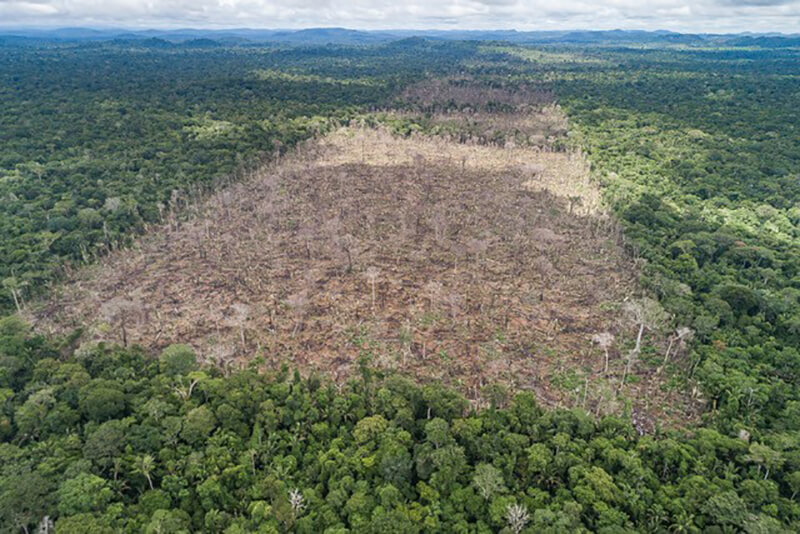In 2019, unprecedented wildfires destroyed thousands of square miles of Amazon rainforest, roughly the size of New Jersey. The loss of biodiversity and invaluable habitats, release of carbon from the fires, and other socioeconomic and environmental consequences have concerned scientists around the world.
An international team led by researchers at Purdue University, the University of Lleida and the Forest Sciences Centre of Catalonia, both in Spain, used remote sensing platforms to understand the relationship between land cover and the 2019 fires. They reported in the journal Environmental Research Letters that the fires were mostly located in areas with substantial forest loss in the previous year.
“A rainforest, if intact, retains moisture and is unlikely to catch on fire. Humans are disturbing the rainforest by removing tree cover and vegetation, and what remains gets drier and drier, creating conditions in the remaining forest ripe for combustion,” said Jingjing Liang, a Purdue assistant professor of quantitative forest ecology and a corresponding author of the paper. “We saw that almost all of the fires happening to the Amazon rainforest in 2019 were happening in areas affected by recent deforestation.”
Using the Visible and Infrared Imaging Radiometer Suite (VIIRS), a satellite-based sensor that monitors changes in surface vegetation properties, the scientists saw that about 85% of the 2019 fires happened just adjacent to areas that had been deforested the year earlier. That deforestation decreased canopy cover, reducing moisture in the forest, increasing forest temperature and wind speeds, and lowering humidity.
“Monitoring and controlling deforestation on a global scale using satellites and big data processing is key to protecting ecosystems and adopting policy measures to improve their conservation,” said Adrián Cardil, first author of the study and researcher of the Global Forest Biodiversity Initiative Hub at the Forest Sciences Centre of Catalonia. “Regimes of forest fires in the world are different depending on the biome in which they occur as well as on the socioeconomic factors determining their occurrence and spread. Understanding the patterns leading to drastic changes in fire regimes, especially in fire-vulnerable areas such as the Amazon basin, is vital for the conservation of ecosystems and the environmental and social functions they provide.”
Fires in the Amazon rainforest are mostly driven by land-use change dynamics arising from forest clearing and burning for continued agricultural expansion, but other anthropogenic factors are also at play.
“Climate change impacts may be also leading to drier conditions and increased fire incidence in rainforests,” said Sergio de Miguel, an associate professor at the University of Lleida and a corresponding author of the study. “Therefore, coupled land-use change and climate change feedbacks are contributing to a perfect storm with potential serious ecological and socioeconomic consequences at the local, regional and global levels.”
The Amazon rainforest is critical for global carbon storage. Its loss to fires diminishes that storage and adds carbon to the atmosphere. Continued fires could lead to significant landscape changes, turning rainforest into grasslands or savannas, with ripple effects into other parts of the planet.
“You could push this ecosystem over and wind up with something completely different. About 70% of the animal and plant species, many of them rare and fragile, are in these equatorial regions of the world, and it wouldn’t take much change to push them toward extinction,” said Bryan Pijanowski, a Purdue professor of landscape and soundscape ecology and a co-author of the paper. “Changes in the Amazon can also have this bottom-up effect. Regional changes there may impact temperatures, rainfall and other climate variables all over the planet.”
The authors point to legislation that has encouraged rainforest privatization and agricultural expansion as driving some of the problem. They suggest integrated forest management policies to regulate environmental and economic activities, engage stakeholders and implement more sustainable forest practices.
“A lack of public engagement and weak enforcement to curb illegal logging and deforestation have to be addressed,” said Mo Zhou, a Purdue assistant professor of forest economics and management and a co-author of the paper. “It will be important to harmonize policies at the local, national and international levels.”
 Deforestation of the Amazon rainforest, often for agricultural purposes, creates conditions that are conducive for fires. Researchers at Purdue University, the University of Lleida and the Forest Sciences Centre of Catalonia in Spain used remote sensing technology to show that 85% of the Amazon rainforest fires of 2019 were in areas that had been deforested just the year before. (Photo courtesy of André Dib.)
Deforestation of the Amazon rainforest, often for agricultural purposes, creates conditions that are conducive for fires. Researchers at Purdue University, the University of Lleida and the Forest Sciences Centre of Catalonia in Spain used remote sensing technology to show that 85% of the Amazon rainforest fires of 2019 were in areas that had been deforested just the year before. (Photo courtesy of André Dib.) 




